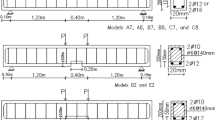Abstract
This paper deals with the structural performance of composite reinforced concrete beams made of two different concretes, bonded together using epoxy resin. The fabricated beam section consists of low-strength reinforced concrete core and relatively large thickness outer skin concrete jacket without reinforcement. The results confirm that the bonding technique used for constructing the composite section is effective. Flexural strength of the tested beam is mainly governed by the outer jacket thickness followed by the compressive strength of concrete. A simple flexural analytical model was developed to calculate moment capacity of composite sections. The predictions were found accurate and can be utilized for the flexural analysis and design of composite reinforced concrete beams. A parametric study was made to investigate the effects of core reinforcement and both composite section geometry and material properties on the depth of compression zone and moment capacity of the section.
















Similar content being viewed by others
Abbreviations
- a :
-
Shear span
- A s :
-
Area of steel rebar
- b :
-
Beam width
- c :
-
Depth of compression zone
- d :
-
Effective depth
- fco′:
-
Compressive strength of core
- fc′:
-
Compressive strength of outer skin
- f tu :
-
Tensile strength of concrete
- f sp :
-
Splitting tensile strength
- f y :
-
Yield stress of steel rebar
- h :
-
Height of core
- h t :
-
Height of composite section
- M u :
-
Ultimate moment
- P u :
-
Ultimate load
- R tt :
-
Ratio of thickness of outer skin at tension to composite section’s height
- R tc :
-
Ratio of thickness of outer skin at compression to composite section’s height
- R ts :
-
Ratio of thickness of outer skin at sides to composite section’s width
- t :
-
Thickness of outer skin
- t f :
-
Thickness of flange
- t w :
-
Thickness of web
- α, β, γ, ψ :
-
Coefficients
- Φ b :
-
Bond reduction factor
References
ACI Committee 318 (2015) Building code requirements for structural concrete. American Concrete Institute. Farmington Hills, First Printing
Alaee FJ, Karihaloo B (2003) Retrofitting of reinforced concrete beams with CARDIFRC. ASCE J Comp Consr 7(3):174–186
ASTM C204 (2013) Standard test method for fineness of hydraulic cement by air-permeability apparatus, Annual Book of ASTM Standard, vol 04
BS EN 12390-1 (2000) Testing hardened concrete—part 1 shape, dimensions and other requirements for specimens and moulds
Chalioris CE, Pourzitidis CN (2012) Rehabilitation of shear-damaged reinforced concrete beams using self-compacting concrete jacketing. Int Scho Res Net Civil Engg, ID 816107
Chalioris CE, Pourzitidis CN (2012b) Self-compacting concrete jacketing—tests and analysis. AASRI Procedia 3:624–629
El-Sayed TA, Erfan AM (2018) Improving shear strength of beams using ferrocement composite. Constr and Buil Mat 172:608–617
Eurocode 2 (2004) Design of concrete structures—part 1: general rules and rules for buildings. CEN, Brussels
Fahmy EH, Shaheen YBI, Abdelnaby AM, Abou Zeid MN (2014) Applying the ferrocement concept in construction of concrete beams incorporating reinforced mortar permanent forms. Int J Concr Struct Mater 8(1):83–97
Foti D (2014) Prestressed slab beams subjected to high temperatures. Compos Part B 58:242–250
Foti D, Vacca S (2013) Mechanical behavior of concrete columns reinforced with rheoplastic mortar. Materiales de Construcción 63:267–282
Habel K (2004) Structural behavior of elements combining ultra-high performance fiber reinforced concrete (UHPFRC) and reinforced concrete, Ph.D. thesis, Ecole Polytechnique Federal De Lausanne, Switzerland
Habel K, Denarie E, Bruhwiler E (2007) Experimental investigation of composite ultra high performance fiber reinforced concrete and conventional concrete members. ACI Str J 104(1):93–101
Hassan HF (2015) Behavior of hybrid deep beams containing ultra high performance and conventional concretes. J Eng Technol 33(1 Part A):30–50
Kaushik SK, Daubey AK (1994) Performance evaluation of RC ferrocement composite beams, ferrocement. In: Proceedings of the 5th international symposium, pp 240–256
Kaushik SK, Garg VK (1994) Rehabilitation of RC beams using precast ferrocement bonded plates, ferrocement. In: Proceedings of the 5th international symposium, pp 258–267
Meddah MS, Bencheikh M (2009) Properties of concrete reinforced with different kinds of industrial waste fibre materials. Constr Build Mater 23:3196–3205
Mohammadi Y, Singh SP, Kaushik SK (2008) Properties of steel fibrous concrete containing mixed fibres in fresh and hardened state. Constr and Buil Mat 22:956–965
Mohammed AA, Assi DK, Abdulrahman AS (2015) Tests on tensile and compressive strengths of high strength concrete containing silica fume. In: Proceedings of SELTH 2015—International Scientific Conference of the Romanian-German University of Sibiu (2015), pp 301–308
Raj J, Jeenu G (2010) Flexural behavior of UHPC-RC composite beams. In: Proceedings of the international conference on technological trends (ICTT-2010)
Sarsam KF, Mohammed MH (2004) Flexural strength of hybrid beams containing reactive powder concrete and conventional concrete. J Eng Develop 18(5):61–91
Shaheen YBI, Safan MA, Abdalla MA (2012) Structural behavior of composite reinforced ferrocement plates. Concr Res Lett 3(3):477–490
Shanour AS, Said M, Arafa AI, Maher A (2018) Flexural performance of concrete beams containing engineered cementitious composites. Constr Build Mater 180:23–34
Silva ER, Coelho JFJ, Bordado JC (2013) Strength improvement of mortar composites reinforced with newly hybrid-blended fibers: influence of fibers geometry and morphology. Constr Build Mater 40:473–480
Author information
Authors and Affiliations
Corresponding author
Rights and permissions
About this article
Cite this article
Mohammed, A.A., Ali, T.K.M. Flexural Behavior of Composite Concrete–Epoxy–Reinforced Concrete Beams. Iran J Sci Technol Trans Civ Eng 44, 549–563 (2020). https://doi.org/10.1007/s40996-019-00255-1
Received:
Accepted:
Published:
Issue Date:
DOI: https://doi.org/10.1007/s40996-019-00255-1




